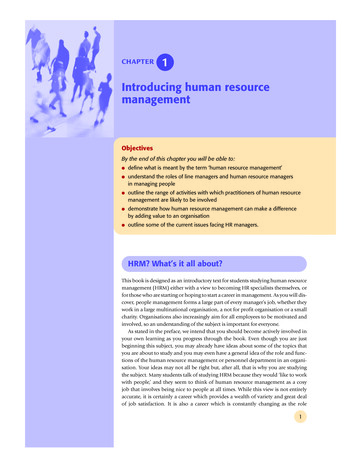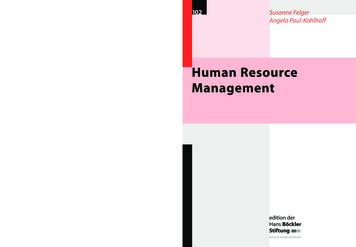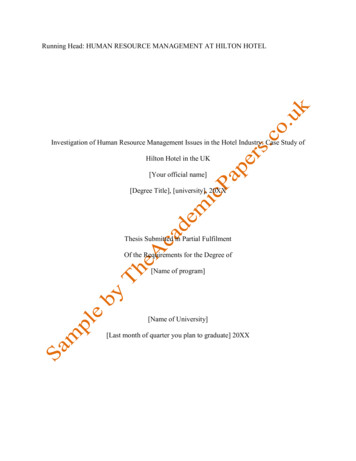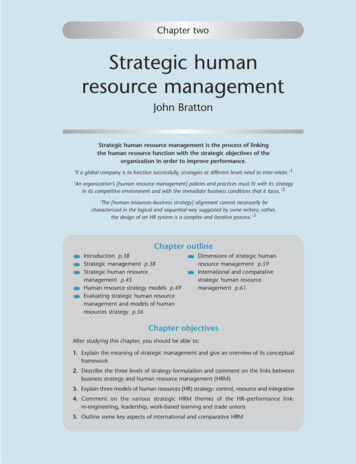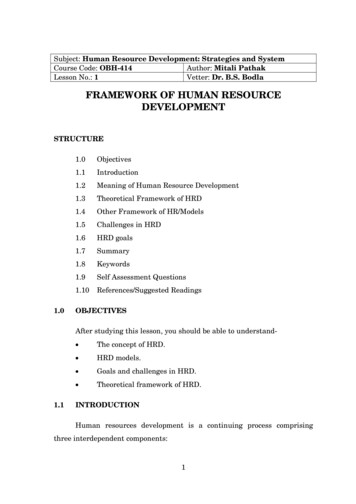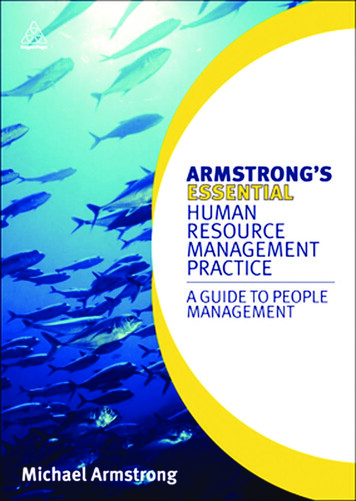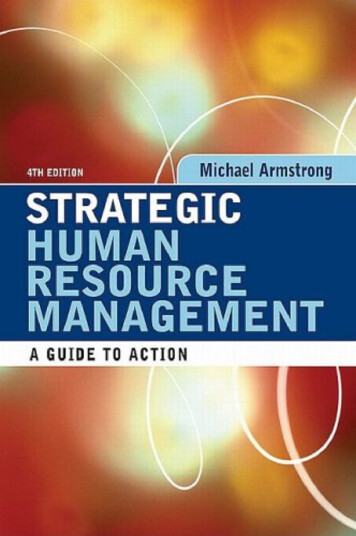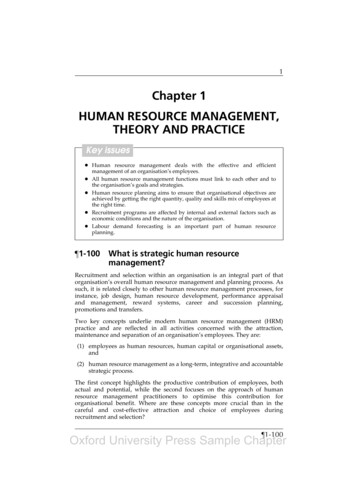
Transcription
1Chapter 1HUMAN RESOURCE MANAGEMENT,THEORY AND PRACTICEKey issues Human resource management deals with the effective and efficientmanagement of an organisation’s employees. All human resource management functions must link to each other and tothe organisation’s goals and strategies. Human resource planning aims to ensure that organisational objectives areachieved by getting the right quantity, quality and skills mix of employees atthe right time. Recruitment programs are affected by internal and external factors such aseconomic conditions and the nature of the organisation. Labour demand forecasting is an important part of human resourceplanning.¶1-100What is strategic human resourcemanagement?Recruitment and selection within an organisation is an integral part of thatorganisation’s overall human resource management and planning process. Assuch, it is related closely to other human resource management processes, forinstance, job design, human resource development, performance appraisaland management, reward systems, career and succession planning,promotions and transfers.Two key concepts underlie modern human resource management (HRM)practice and are reflected in all activities concerned with the attraction,maintenance and separation of an organisation’s employees. They are:(1) employees as human resources, human capital or organisational assets,and(2) human resource management as a long-term, integrative and accountablestrategic process.The first concept highlights the productive contribution of employees, bothactual and potential, while the second focuses on the approach of humanresource management practitioners to optimise this contribution fororganisational benefit. Where are these concepts more crucial than in thecareful and cost-effective attraction and choice of employees duringrecruitment and selection?Oxford University Press Sample Chapter¶1-100
2Effective Recruitment and Selection PracticesSocial, economic, political and workplace relations changes, together withdevelopments in the human resource (HR) profession, have propelledpractitioners towards innovative managerial perspectives, approaches andstrategies. New skills, especially in the information technology/telecommunications and accounting areas, need to be acquired, applied andevaluated. Economic fluctuations, legislative developments in areas such asworkplace relations, equal employment opportunity, privacy and workplacehealth and safety, environmental and quality of work life issues providehuman resource practitioners with both pressures and opportunities.Restrictions on recruitment strategies and selection techniques are balanced byopportunities to grow current employees in innovative and creativedirections.Human resource management as a profession is concerned with the effectiveand efficient management of an organisation’s employees (human resources)towards the achievement of desirable objectives and goals. It has displacedearlier models (eg personnel administration, personnel management) becauseof its emphasis on the integration of all traditional personnel functions (eg jobdesign, recruitment and selection, human resource development, rewardssystems, career management, etc) and their management towardsorganisational strategic outcomes and objectives.Human resource management involves a perception that employees arehuman resources (or even human capital), not unlike other organisationalresources such as finance and technology, who need to be managed in similar(and different) ways in order to achieve productivity and profitabilityoutcomes. Specific human resource management functions then provide themeans by which employees are acquired (eg human resource planning, jobdesign, recruitment and selection), developed (eg human resource development,reward and remuneration systems, performance and career management) andultimately terminated (eg dismissal, retirement and redundancy programs)according to organisational requirements. It thus involves a human resourcemanagement strategy and a human resource management plan, consistentwith overall organisational strategies, which subsequently feed into each ofthe related human resource functions.Oxford University Press Sample Chapter¶1-100
Human resource management, theory and practice3Diagram 1.1: Recruitment as a strategic HRM toolSource: Nankervis, A, Compton, R, Baird, M, Coffey, J, 2011, Human resourcemanagement: strategies and processes, 7th edn, Cengage, Melbourne, p 34.Diagram 1.1 illustrates the ideal relationships between organisational andhuman resource management strategies, plans and functions, and highlightsthe centrality of recruitment and selection in the overall human resourcemanagement framework.Two important concepts in strategic human resource management are those ofhorizontal and vertical alignment. Horizontal alignment refers to the need forhuman resource professionals to ensure that all human resource managementfunctions (eg job design, recruitment and selection, human resourcedevelopment, performance management, remuneration, retrenchment, etc) areclearly linked to each other and to the organisation’s goals. As an example, anorganisation intending to expand overseas would need to ensure that: it could attract skilled and experienced technical and managerial stafffrom Australia or in international markets it was using the most suitable recruitment and selection techniques, and its remuneration and career development/retention programs matchedits advertised attractions.On the other hand, its human resource professionals would need to ensurethat all these functions reflected the organisation’s culture, budgets andlonger-term strategies. Culture, budgets and strategies are among the requiredaspects to be considered to achieve vertical alignment with an organisation’sgoals and plans. Two other concepts, of internal and external ‘‘fit’’, are also ofimportance here. Internal fit suggests that all human resource managementfunctions should be designed according to an organisation’s internal culture;whilst external fit refers to the need for all organisations to tailor their HROxford University Press Sample Chapter¶1-100
4Effective Recruitment and Selection Practicesprograms to the demands of their (external) industry, national and regionalcontexts (‘‘dynamic environments’’ in Diagram 1.1).While practical evidence on the role of HR professionals as ‘‘strategic businesspartners’’, demonstrating both horizontal and vertical alignment, internal andexternal fit, is limited, there are some promising indications of its applications.Recent studies (Guest, D, 2011, ‘‘HRM and performance: still searching forsome answers’’, HRM journal, 21(1), pp 1–13; Butler, P, McEvoy, G, 2012,‘‘Strategic human resource management and performance: sharpening line ofsight’’, HRM review, 22, pp 43–56) reveal significant contributions of humanresource management systems to organisational performance, with the latterauthors concluding that ‘‘much of the recent research suggests that HRMpractices can positively affect firm performance, primarily through theirimpacts on human and social capital . . . the HRM objectives are to establishand promote a clear alignment of capabilities at all levels with the firm’sstrategic goals and to create the culture, norms, motivation and opportunity toengage in actions that contribute to these goals’’ (p 54).Diagram 1.2 below shows the HR professional capabilities (competencies)considered by the Australian Human Resources Institute (AHRI) as essentialcomponents of a business-driven approach to the human resource practitionerroles.Diagram 1.2: AHRI model of excellence — Driving your successSource: HR Competency Model (Ulrich & Brockbank 2007) and AHRI HR ManagementModel 2003.Human resource management is comprised of a number of interrelatedactivities that combine to drive business performance. With a base capabilityof being business driven, HR professionals require the following additionalOxford University Press Sample Chapter¶1-100
Human resource management, theory and practice5capabilities: strategic architect, stakeholder manager, workforce designer,credible activist, expert practitioner, and culture and change agent. Humanresource management knowledge and capability underpin HR practice andinfluence the professional behaviour of HR professionals and how they areperceived. In addition, the overarching goal of people leading business isunderpinned by the following four HR objectives: contribute to a profitable and sustainable organisation increase workforce competency and engagement develop excellence in people management create a dynamic and productive work environment.All of these ‘‘capabilities’’ may be displayed in the specific recruitment andselection functions of human resource management, but perhaps the mostimportant ‘‘capabilities’’ for HR practitioners are those of workforce designer,stakeholder manager, expert practitioner, culture and change agent. Thus, asworkforce designers, practitioners will be engaged in decisions about thestructure, clusters, and tasks involved in particular jobs; as stakeholdermanagers, they manage the expectations of managers, work groups andpotential new employees; as expert practitioners, they must demonstrate theircompetence in the design of effective recruitment and selection processes; andas culture and change agents, use these processes to ensure that newemployees fit into their jobs and work teams.From a human resource management perspective, recruitment and selectionreflect broader staffing strategies, and represent the first stage of themanagement of human resources (employees) towards organisational goals.They can be considered as the most difficult and yet the most crucial of allhuman resource management strategies. Acquiring the best applicants can bea huge bonus to organisations, but hiring less than the best can result inenormous disruption, reduced productivity, interpersonal difficulties andinterruptions to teamwork, customer service problems, and long-term costs.As both stakeholder managers and expert practitioners, HR professionals areusually the key organisational informants, interpreters, and advisers withrespect to the workplace impacts of existing and new federal and elations,diversity/discrimination, workplace health and safety, equal employment andprivacy. Perhaps the most important contemporary pieces of legislationrequiring advice from HR professionals in Australia are the Fair Work Act2009, established under the Rudd-Gillard Labor federal government, and thecurrent amendments proposed by the Fair Work Amendment Act 2013 underthe Abbott Liberal government. Together with the new employerresponsibilities associated with the national ‘‘harmonisation’’ of workplacehealth and safety legislation, HR professionals will undoubtedly be requiredto provide considerable interpretative and practical advice on their workplaceimplications. More details on the inclusions and implications of these Acts areincluded in Chapter 3, Legislation and legal issues.Oxford University Press Sample Chapter¶1-100
6Effective Recruitment and Selection PracticesGetting recruitment and selection processes and techniques right the first timeis crucial and is the product of: knowing what you want and where to get it (human resource planning) being able to specify the required skills, attitudes and interpersonal skills(job design) to perform the job(s), and subsequently providing appropriate challenges, development, rewards andopportunities (human resource development, remuneration systems,career and succession plans) to satisfy and motivate qualified applicants.This book explores the various methods and techniques to choose the rightapplicants for all organisational positions.We will first consider human resource plans and their relationships withcorporate plans.¶1-150Human resource planning and the strategicbusiness planDescribed in the past as employment, workforce or manpower planning,human resource planning is ideally a continuous process which aims toensure that organisational objectives are achieved by obtaining the rightquantity and quality of employees at the right time and right costs, with anappropriate skills mix. Human resource planning involves analysis of thestaffing impacts of industry or organisational growth, decline ordiversification and consequent development of corresponding recruitment, reskilling, outsourcing, re-deployment or redundancy strategies. Manycompanies have built a combination of short-term contracts, 457 visas, andoutsourced service suppliers into their recruitment ‘‘mix’’, in order to bothaccommodate their dynamic staffing needs and to allow them to better assesstheir potential ongoing employees. The Fair Work Act 2009 restricted some ofthese employment options, and it is yet to be seen whether the amendmentsproposed to it by the Abbott federal government will relax these constraints.Human resource planning can be defined in various ways. For example, it hasbeen explained thus: ‘‘estimating the future supply of and demand for humancapital and then figuring out how to close the gaps. Such planning allowscompanies to think through their workforce alternatives to the high fixedcosts of full-time employees’’ (BCG, 2010, Creating people advantage 2010: howcompanies can adapt their HR practices for volatile times, BCG & WFPMA, Boston,p 21). More broadly, it is a continuing process of analysing an organisation’shuman resources needs under changing conditions to ensure that the rightnumber of people with the right skills, and at the right costs are available atthe right time for the organisation. More narrowly, it may simply be describedas the complex science (or art) of matching labour demand with laboursupply. These definitions suggest that staffing plans should derive from, andbe consistent with, both short-term and long-term goals and objectives of theorganisation, and should in turn inform human resource managementfunctions, such as job design, recruitment and selection, human resourcedevelopment and performance management. Evaluation of the effectiveness ofOxford University Press Sample Chapter¶1-150
Human resource management, theory and practice7each of these functions (see Chapter 13, Evaluation of recruitment and selection)should then feed back into human resource plans in order to further improvetheir capacity to deliver the right employees with the right skills andcompetitiveness, according to organisational requirements.Accordingly, recruitment techniques will vary from time to time. In periods ofgrowth, alternative sources of contract staff or long-term staff may be sought.During industry decline, internal development activities, retrenchments orearly retirement programs (sometimes called ‘‘negative recruitment’’) may beemphasised. Selection strategies will also differ, consistent with corporatedevelopments.Ideally, human resource planning focuses on both the strategic (or long-term)and operational (short-term) perspectives. Long-term covers up to five yearsand short-term less than one year, depending on the nature of the industry.Recruitment and selection should therefore focus on both filling current jobvacancies and preparing for future staffing needs.More recently, some writers have suggested that human resource planning isa crucial component of ‘‘human capital management’’, which refers to theprocess of measuring (and managing) the alignment of human resourcemanagement and organisational goals, from the perspectives of allstakeholders, including managers, shareholders and investors. It aims to‘‘understand and support (HRM) activities that create sustainable capabilityand external shareholder value’’ (Donaldson, C, 2006, ‘‘Intangibles crucial inHR’s future’’, Human resources, 107(27), June, p 1), or more specifically, toensure that ‘‘organisational capabilities such as talent, speed, collaboration,accountability, shared mindset, learning and leadership are the deliverables ofHR . . . which contribute to an organisation’s market value’’ (Kramar, R, 2006,Cranet Macquarie survey on international strategic human resource management:report on the Australian findings, Macquarie University, Sydney, p 7).The complexity of human resource planning techniques will vary withorganisational size and the dynamic nature of the organisation or its industrialenvironment, and the perception and status of the human resource function.Most modern organisations engage in forward planning from time to time, toenable the determination of overall objectives, future directions andopportunities for growth and productivity. This is usually referred to asstrategic (corporate) planning.As a result of such plans, structures, budgets and resources can be reviewed totake advantage of economic, social, labour market, product or industrychanges. Changes in global, regional or national economies, including theconstant restructuring of the Australian economy, financial crises, fluctuatingcurrency rates, increasing international competition, cross-generational issues,different work attitudes and workplace relations developments, together withmodern management theories, have highlighted the importance of strategicplanning to achieve organisational success. All these factors have a significantimpact on the nature of recruitment and selection programs.Oxford University Press Sample Chapter¶1-150
8Effective Recruitment and Selection PracticesSuch long-term planning is usually undertaken by a team of senior managersin close liaison with the Chief Executive Officer and the Board of Directors.The process commonly involves the following five stages.STRATEGIC PLANNING PROCESS(1) Development of a clear mission statement, core vision or prime objective.(2) Review of likely pressures and opportunities both within and outside theorganisation.(3) Formulation of alternative scenarios and optional strategies. It should alsoindicate the proportions of full-time, part-time, contract, casual andoutsourced positions, with the view to aligning staff requirements to thedynamic demands of organisations.(4) Choice of the most effective options.(5) Preparation of objectives, targets, budgets and operational business plans.The process is cyclical, incorporating contingency strategies and in-builtmonitoring and review processes.With growing recognition of the value and costs of an organisation’s humanresources, most organisations now actively integrate human resource planswith corporate plans (see Diagram 1.1). The human resource manager shouldbe well placed to advise on labour market trends, legislative and statutoryrequirements, and the staffing impacts of product or service diversification,relocation, growth or decline. With the support of an efficient human resourcemanagement information system (HRIS) (see Chapter 11), practitioners canprovide a wealth of data relevant to corporate planning. Fully-costed humanresource plans will indicate the relative viability of scenarios and alternativestrategies.Human resource management policies and practices can be linked to strategicmanagement in at least three ways:(1) They can be used to reinforce existing corporate strategies (eg throughperformance management or job and work group redesign to improveproductivity).(2) They can be used to signal and reinforce changes in corporate strategies(eg through the shaping of existing or injection of new corporate values,or the development of new workforce skills).(3) Human resource data can be used as an input into the strategic planningprocess (eg employee survey data can be used to guide priority setting orprogram development, or human resource planning and employeedemographic data can be used to assess the viability of plans fordiversification, expansion or contraction).Oxford University Press Sample Chapter¶1-150
Human resource management, theory and practice9The relationship between human resource planning and strategic planning isshown in the following chart.Both human resource planning and corporate planning are by nature subjectto variables within the economy, society, the organisation itself and itsemployees. However, despite its unpredictability, such integrated planning iscrucial for organisational success. Effective planning will directly influence thecontent of position descriptions, the choice of recruitment strategies andselection techniques.The key external and internal environmental factors (see chart above) whichare likely to influence future HR plans in Australian organisations include(but are no means limited to) the following local, regional and global trends.The ‘‘8 forces’’ facing Australian and regional economies in the next decadesOxford University Press Sample Chapter¶1-150
10Effective Recruitment and Selection Practiceshave been summarised as global competition, new technology andcommunication developments, an increasing demand for employee flexibility,‘‘skills convergence in multi-disciplinary environments’’, global best practice,changing business standards (notably ethical and corporate socialresponsibility issues), and dynamic governmental regulations (Wilson, P,2010, People@Work, AHRI, Melbourne, p 3). More specific issues includeemerging skills shortages in a variety of industry sectors and occupations, atboth professional and technical levels; an ageing workforce in Australia andother regional countries (for example, China, Singapore, Japan) contrastedwith youthful labour markets in India and Indonesia; workplace intergenerational conflict; and ongoing industry sectoral shifts.With respect to the latter, the resources, manufacturing, aviation, and retailindustry sectors in Australia have all been adversely affected by acombination of increased global and regional competition, the development ofnew technologies, and currency fluctuations. For example, the mining ‘‘boom’’of the early 2000s, which provided significant levels of employment forworkers in Western Australia and Queensland together with contractual jobsfor employees from other states, is now abating. The closure of the Ford MotorCompany and the imminent demise of General Motors signals the end ofvehicle manufacturing in Australia, whilst the deteriorating financial positionof Qantas is likely to result in significant numbers of unemployed skilledworkers. Global online sales have also provided more traditional retailers withconsiderable HRM challenges.Whether human resource plans form an integral component of corporateplans will depend on the foresight, status and skills of human resourceprofessionals.¶1-200Benefits of human resource planningThe principal purpose of human resource planning is to ensure thatorganisations have sufficient staff with the required skills, knowledge andabilities to cost-effectively produce the goods or services required to achieveorganisational objectives.The human resource planner must therefore forecast staffing requirementsand predict labour supply as well as ensure the effective integration of allhuman resource activities. Thus, job analyses must produce positiondescriptions that accurately reflect job content, while allowing fortechnological change. Job design, job rotation or promotion programs mayreduce or remove the need for expensive recruitment and selection processes.Organisational restructuring, involving substantial staff redundancies, mayalter these staffing plans and processes. Alternatively, accurate positiondescriptions will make those processes more effective when they have to beused.For example, in the information technology industry, specific long-term skillsrequirements may be difficult to determine due to the dynamic nature of theindustry. Position descriptions and recruitment policies will therefore need toreflect this uncertainty by providing for both short-term (such as the use ofOxford University Press Sample Chapter¶1-200
11Human resource management, theory and practicecasual or contract employees) vacancy-filling as well as longer-term careerprospects. These days, many of these skills have been contracted out (oroutsourced) as an efficiency and cost-cutting exercise.Successful induction followed by ongoing human resource developmentassists in the motivation and maintenance of valued employees who mayotherwise be poached by attractive offers from competitors. Efficientlyconducted performance management programs can assist salarysupplementation and career and succession planning procedures. All humanresource functions therefore benefit from a well-prepared, realistic andcarefully-monitored human resource plan linked to the overall corporatestrategy.Recruitment and selection programs must be linked with other humanresource systems, especially performance appraisal, career management,rewards schemes and data analysis programs, as well as being integrated intothe overall human resource plan.In summary, the benefits of human resource planning include: the provision of clear linkages between human resource functions andorganisational objectives more focused sourcing of workers from both traditional and nontraditional labour markets cost-effective recruitment and selection strategies, and systematic and responsive human resource policies and practices in allareas.Human resource planning, while of immense benefit to both practitioners andsenior management, also has its drawbacks, including the time required, andthe difficulty in achieving accuracy and the correct focus. Good planning takestime, and senior management time is expensive. Plans may be subject to alarge number of unpredictable variables (employment levels, demographicaspects, skill variations, economic factors) demanding multiple contingencystrategies. Finally, practitioners themselves may consider the focus onemployees as resources distasteful. Despite these disadvantages, humanresource plans that are clearly integrated with corporate plans are becomingessential for modern human resource practice.¶1-250Linking recruitment and selection with thestrategic business planAs discussed earlier, both the horizontal and vertical alignment of humanresource management goals, strategies, policies and functions with thestrategic business plan are crucial to strategic human resource management.Nowhere is this more important than with an organisation’s recruitment,selection and retention functions. The stage of an organisation’s development(that is, whether it is just starting up, in a growth phase, merging with anothercompany, or even in decline) will indicate the numbers and types ofemployees it requires in both the short and longer terms. Human resourceplanning will, for example, provide organisational planners with details of theOxford University Press Sample Chapter¶1-250
12Effective Recruitment and Selection Practicesdesired demand for human resources in the business planning period, theirlevels of qualifications, amount of work experience, and any particular skills(eg linguistic, cross-cultural, managerial, e-commerce). This aspect of humanresource planning is generally referred to as labour demand forecasting.Unfortunately, not all organisations conduct such forecasting effectively. Forexample, at the beginning of the resources boom in the early 2000s, thedemand for contingent labour was so immense that very high salaries neededto be paid to attract skilled employees (carpenters, plumbers, geologists andengineers) to mines in Western Australia and Queensland, usually on ‘‘fly infly out’’ (FIFO) or ‘‘drive in-drive out’’ (DIDO) contracts. Currently, now thatthis sector is in decline, many contracts have been terminated withoutcomprehensive plans for future staffing needs. General Motors’ plan to closeits automobile manufacturing plants in Adelaide and Melbourne by 2018, onthe other hand, provides the American company with opportunities todevelop an HR plan to assist its workers to re-settle themselves in newoccupations, with potentially less adverse effects on their company brand andits products. It remains to be seen how successful its approach will be.Labour demand forecasting includes both positive recruitment (ie theidentified need for more or more highly qualified additional staff) andnegative recruitment, which may mean the retrenchment of existingemployees in redundant jobs, or the outsourcing of organisational functionsno longer considered essential to the organisation’s core business (eg payrolladministration, cleaning or cafeteria services, information technology supportservices, etc). The associated human resource plan should cover both of theseaspects. In the case of mergers or takeovers, it will need to balance thenumbers and types of employees required for the new organisation from theformer ones. It should also specify whether new staff will be hired onpermanent, contract or casual basis, and their associated conditions andentitlements. These, of course, should derive from the organisation’s financialplans.¶1-300The role of recruitment in human resourceplanningIn the context of human resource planning, it is necessary to match futureworkforce requirements with the labour supply (both internal and external).Often this will mean recruitment in advance of actual requirements so that thenecessary training and development of, for example, graduates andapprentices can take place. Usually, a balance will need to be reached betweenrecruiting for immediate needs and recruiting for internal training,development or promotion.Basically, the need for recruitment is determined by forecasting the number ofemployees needed in the future and making allowance for labour turnoverrates during that period (generally based on past turnover rates), as well asthe impact of transfers, promotions and planned redundancies. The techniqueof recruitment as a means of closing supply/demand gaps must be comparedfor effectiveness with other alternatives, such as increased human resourceOxford University
DCCH AUSTRALIA LIMITED Date: 24-APR-14 Time: 16:30 Seq: 3 Human resource management, theory and practice 3 Diagram 1.1: Recruitment as a strategic HRM tool Source: Nankervis, A, Compton, R, Baird, M, Coffey, J, 2011, Human resource management: strategies and processes, 7th edn, Ceng



